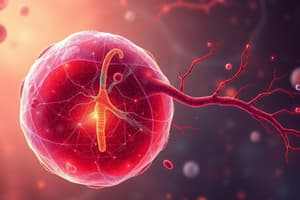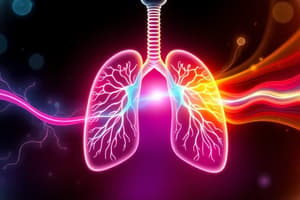Podcast
Questions and Answers
Explain the function and model system of the Patellar-tendon stretch reflex (Knee-jerk reflex).
Explain the function and model system of the Patellar-tendon stretch reflex (Knee-jerk reflex).
The function of the Patellar-tendon stretch reflex is to obtain a mechanistic understanding of a simple reflex behavior. It is a monosynaptic reflex. The model system for this reflex is the Knee-jerk reflex.
Describe the components of the nervous system and neuronal structure.
Describe the components of the nervous system and neuronal structure.
The components of the nervous system include the central nervous system (CNS) and the peripheral nervous system (PNS). The neuronal structure consists of membrane structure, pumps, channels, and resting membrane potential.
Explain how an action potential is generated and transmitted.
Explain how an action potential is generated and transmitted.
An action potential is generated by the depolarization of the neuron's membrane, which leads to the opening of voltage-gated sodium channels. The action potential is then transmitted along the neuron's axon through the process of depolarization and repolarization.
How does the signal travel from neuron to muscle in the muscle synapse?
How does the signal travel from neuron to muscle in the muscle synapse?
What are the learning objectives related to the nervous system and muscle synapse?
What are the learning objectives related to the nervous system and muscle synapse?
What is the goal of studying the stretch reflex and withdrawal reflex?
What is the goal of studying the stretch reflex and withdrawal reflex?
Explain the role of sodium and potassium ions in maintaining the resting membrane potential.
Explain the role of sodium and potassium ions in maintaining the resting membrane potential.
What determines the resting membrane potential?
What determines the resting membrane potential?
How do leak channels contribute to the resting membrane potential?
How do leak channels contribute to the resting membrane potential?
What are the equilibrium potentials for potassium and sodium ions?
What are the equilibrium potentials for potassium and sodium ions?
Explain the influence of the Na+/K+ ATPase and selective leak channels on the resting membrane potential.
Explain the influence of the Na+/K+ ATPase and selective leak channels on the resting membrane potential.
What are the objectives covered in the text?
What are the objectives covered in the text?
Explain the role of glia cells in the nervous system and their functions.
Explain the role of glia cells in the nervous system and their functions.
Describe the structure of a neuron and the specific components involved in the flow of information.
Describe the structure of a neuron and the specific components involved in the flow of information.
Identify and explain the functions of the three types of neurons found in the spinal cord.
Identify and explain the functions of the three types of neurons found in the spinal cord.
Discuss the importance of the resting membrane potential (Em) and the mechanisms involved in its maintenance.
Discuss the importance of the resting membrane potential (Em) and the mechanisms involved in its maintenance.
What are the components involved in the reflex loop, and how do they collectively generate a reflex response?
What are the components involved in the reflex loop, and how do they collectively generate a reflex response?
Explain the specific functions and structures of different types of neurons, including bipolar, pseudo-unipolar, and multipolar cells.
Explain the specific functions and structures of different types of neurons, including bipolar, pseudo-unipolar, and multipolar cells.
Explain the role of voltage-gated Na+ and K+ channels in action potential generation.
Explain the role of voltage-gated Na+ and K+ channels in action potential generation.
How does muscle stretch or other stretch receptor sensory stimuli lead to action potential generation?
How does muscle stretch or other stretch receptor sensory stimuli lead to action potential generation?
What determines the resting membrane potential of a neuron?
What determines the resting membrane potential of a neuron?
How does the refractory period contribute to the one-directional travel of the action potential?
How does the refractory period contribute to the one-directional travel of the action potential?
Describe the role of interneurons in the patellar-tendon stretch reflex.
Describe the role of interneurons in the patellar-tendon stretch reflex.
What specific stimuli disrupt the steady state and cause ion-selective channels in the membrane to open?
What specific stimuli disrupt the steady state and cause ion-selective channels in the membrane to open?
Explain the role of myelination in neural conduction and how it contributes to increasing conduction speed.
Explain the role of myelination in neural conduction and how it contributes to increasing conduction speed.
Describe the functional significance of electrical synapses in synaptic transmission.
Describe the functional significance of electrical synapses in synaptic transmission.
What is the role of afferent neurons in the nervous system?
What is the role of afferent neurons in the nervous system?
How does myelination affect the refractory period in neural conduction?
How does myelination affect the refractory period in neural conduction?
What are the characteristics of chemical synapses in synaptic transmission?
What are the characteristics of chemical synapses in synaptic transmission?
Explain the classification of afferent fiber types based on diameter and conduction speed.
Explain the classification of afferent fiber types based on diameter and conduction speed.
Flashcards are hidden until you start studying
Study Notes
Neural Conduction, Myelination, and Synaptic Transmission
- Action potential (AP) spreads electrotonically to adjacent membrane, leading to depolarization and generation of new AP
- Electrotonic conduction proceeds in one direction due to refractory period
- Myelination increases speed of electrotonic conduction, formed by Schwann cells in PNS and oligodendrocytes in CNS
- Myelination is discontinuous, with nodes of Ranvier where AP is regenerated
- Myelination enables saltatory conduction, increasing conduction speed by not requiring AP regeneration at every part of the axonal membrane
- Afferent neurons carry information from periphery to spinal cord, efferent neurons carry information from spinal cord to periphery, and interneurons carry information between neurons
- Glia provide structure/support, produce myelin, and form the blood-brain barrier
- Classification of afferent fiber types based on diameter and conduction speed
- Myelinated axons have conduction speed of 12-130 m/sec, while unmyelinated axons have conduction speed of 0.5-2 m/sec
- Absolute refractory period lasts almost 2 msec, allowing AP to travel a certain distance down the axon
- Synaptic transmission involves chemical and electrical synaptic transmission, with functional significance of electrical synapses and bidirectional communication
- Chemical synapses are larger in gap, directly-gated, and involve transmission of signals between pre and post-synaptic cells
Studying That Suits You
Use AI to generate personalized quizzes and flashcards to suit your learning preferences.




